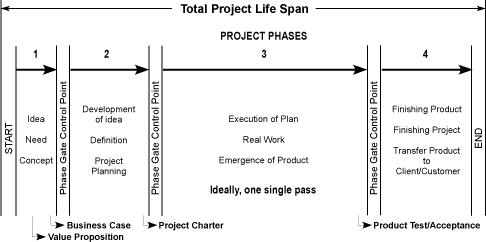The Role of the Project Portfolio Steering Committee
Managing a portfolio does place special demands on project management. As we
noted earlier, where there is any significant number of projects, it is simply
not possible to conduct successful portfolio management unless there is consistent
reporting of data being fed back to the Steering Committee.
Without interfering in the project management process, or trespassing on the
program/project management responsibilities of a PMO, the Steering Committee will
want to gain a regular overview picture. This will include indications of project
progress with a view to cancellation and substitution if very unsatisfactory,
the status and availability of resources, the performance and reception of deliverables,
and so on. This means that there MUST be standard project management processes
and procedures in place.
The Most Important Process: Design of a Common Project
Life Span
Perhaps the most important standard project management process, from the portfolio
perspective, is a gated project life span methodology within which the appropriately
adopted methodology for the technology is conducted. That is because overall portfolio
progress status reporting depends on receiving reports from project management,
especially at key milestones, that are in a consistent format across all projects.
These key milestone reports are typically, and in progressive order: Value
Proposition; Business Case; Project Charter; and Delivery Acceptances as shown
in Figure 3. Standard templates for each of these milestone
documents are available elsewhere.

Figure 3: Idealized high-level gated project management process
From the diagram you will see that each of the documents listed serve quite
different purposes. It is worthwhile emphasizing this point by briefly describing
each in the context of portfolio management as follows.
The Value Proposition is a quick one-page document briefly describing
a potential project or initiative and its justification. It is used for initial
screening and its purpose is to reduce overhead by avoiding unnecessary preparatory
detail by weeding out work that is obviously of little benefit value and/or not
aligned with the overall management strategy. It is a very simplified form of
Business Case. However, for a small project you may decide that it represents
sufficient documentation for the project to proceed through to completion and
product delivery. Apart from this, you may find that the Value Propositions screen
out some 50% of the potential opportunities, while the rest proceed on to a Business
Case
The Business Case is a more elaborate document required to justify a
medium or large project. It is obviously a key document in the early life of a
project or program. It describes the reasons and the justification for the project's
undertaking based on its estimated costs, the risks involved and the expected
future business benefits and value. You may find that the Business Case screens
out, say, another 25% of the potential opportunities. The Business Case provides
the basis for selection and authorization of further expenditure of resources
for detailed investigation, feasibility, planning and so on that will be contained
in a full Project Charter.
The Project Charter is a key approval document in the on-going life
of a medium to large project or program. It provides the project manager with
the authority to consume portfolio resources to execute the project within scope,
quality, time, and cost constraints. The content and effort to prepare the Project
Charter should be scaled to the size of the project. It also provides portfolio
management with the basis for final selection, authorization and release or expenditure
of further resources from within the portfolio.
The Delivery Acceptances of deliverables may be documented in different
ways depending on the nature of the physical items or measurable outputs that
are identified as part of the project's product or objectives. Deliverables can
also include intermediate products or services that are necessary for achieving
the project's final results. These reports will alert portfolio management of
pending project completion, and the transfer of the care, custody and control
of the deliverables over to operations, or to another client or customer.
Coming Next
In Part 4 we will provide tips on Steps 1 to 4.
|



